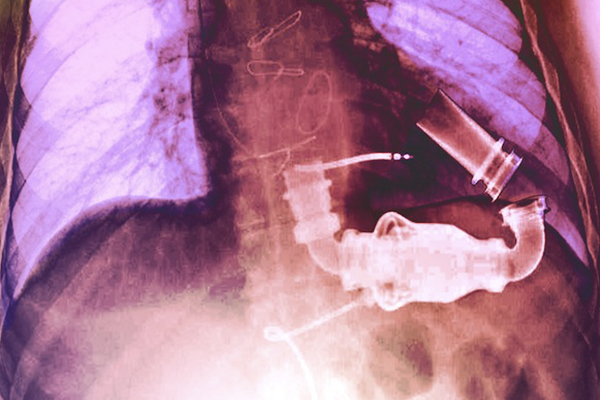On July 29, a team from Emory’s Heart and Vascular Center completed its 500th continuous flow, durable left ventricular assist device (LVAD) implantation, further affirming Emory Healthcare’s status as a national leader in the life-saving procedure.
This year alone, surgeons from Emory’s advanced heart failure team had implanted almost 60 devices by August, a number that has continued to climb steadily since. Currently, Emory Healthcare is the number one LVAD implanting center in the United States.
First used in the 1960s, the ventricular assist device — which has since gone through significant evolution, particularly over the last 20 years — supplies mechanical circulatory support by pumping blood from the ventricles, or lower chambers of the heart, to the rest of the body. Because the device is almost always placed on the left side of the heart, the device is frequently referred to as an LVAD, rather than VAD.
When a patient’s heart has gone into end-stage failure, but they don’t qualify for a transplant, or if it will take too much time to get a transplant, an LVAD provides an alternative course of action that often makes the difference between life and death.
This recent milestone signals an increased capacity to continue offering the consistent and comprehensive quality care that has long drawn heart failure patients to Emory from across the Southeast. Kris Wittersheim, ventricular assist device coordinator at Emory University Hospital, says it’s not unusual for them to see patients from southern Georgia cities like Savannah or Valdosta or neighboring states South Carolina, Alabama and Tennessee.
These procedure’s pace, volume and quality are also a testament to how technological innovations and critical additions to the surgical team have rapidly accelerated how many heart failure patients can receive crucial intervention.
Cardiothoracic surgeon Tamer Attia, MD, PhD, says the process of first determining that an LVAD is the patient’s best option requires a collaborative effort among a wide variety of specialties and skill sets. That multidisciplinary team of 30-40 medical professionals encompasses surgeons, transplant cardiologists, VAD coordinators, pharmacists, nutritionists, social workers, infectious disease experts and palliative care specialists — all to evaluate the best course of action for an extremely sick patient.
Depending on how dire the patient’s situation is, the operation, which can take 5-7 hours, may occur within days of admission to hospital with heart failure symptoms. As with any surgery, there are risks, such as the potential for stroke or infections. But around 90% of the patients are alive one year later and most do well, Attia says — and without the procedure, odds of survival are often slim.
Once the surgery has been completed successfully, the next six weeks require that the patient have a family member or friend who is committed to looking after them 24/7. Therefore, the designated caretakers also undergo extensive training with the Emory team on taking care of their loved ones.
Getting back on one’s feet afterward can take some time. In general, most patients stay in the hospital two to three weeks from the day of the surgery. Recovery on the quicker side can take at least three months, though often more. Most LVAD patients may have been in the hospital for a while, so there is a reacclimating period to “regular life,” says Lakshmi Sridharan, MD, a heart failure and transplant cardiologist with Emory’s Heart and Vascular Center.
Sridharan has counseled many patients before, during and after the LVAD procedure. Sometimes the consultation process beforehand can be a delicate process. While the patient certainly knows this is something that will help keep them from dying, they may not yet fully understand what the device does or how it works. So, the medical team needs to take extra care to explain thoroughly how this will become a major part of their lives moving forward.
After all, this piece of equipment — on a practical level — can change how you look, feel and move. Essentially, it’s high-tech machinery that emerges below the ribs and above the belly button and needs to be plugged in at night to keep you alive.
“I always tell my patients that it takes a long time to heal from an open-heart surgery, and it takes a while to get back to yourself,” Sridharan said. “It changes a lot — you can’t go swimming anymore; you can’t be submerged in water anymore. You have to carry the weight (around 7 pounds) around. That is a lot. We reassure them and let them know it can take some time to adjust.”
Some patients have asked Sridharan whether they’ll ever be able to dress up nicely to go out again. Thankfully, strides have been taken to create a sense of normalcy for LVAD recipients on a day-to-day level. Some innovations specifically designed for LVAD patients include a vest that goes under clothing or a carrier that looks like a purse.
As a result of the comprehensive and intense journey required of their patients, the advanced heart failure team often develops close relationships with those they’ve helped. Sridharan remembers finding ways for one patient to see their dog in the hospital “because that’s what they need to be mentally strong enough to go through the surgery.” She’s also been in situations where they found a way for a patient to wave through a window at their family during the pandemic, a time when absolutely nothing slowed down in the VAD center.
“We say that we’re advanced heart failure doctors, but in some ways, we become their primary care, friends and family. When it’s a life-or-death situation, they are at their most vulnerable,” Sridharan said. “It’s so important to understand their support structure, who they rely on what their coping mechanisms are, and to talk to them on their terms.”

